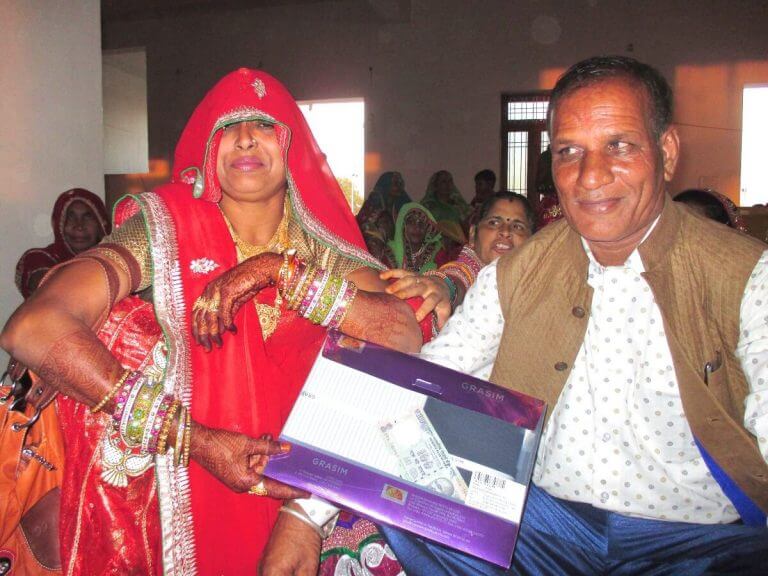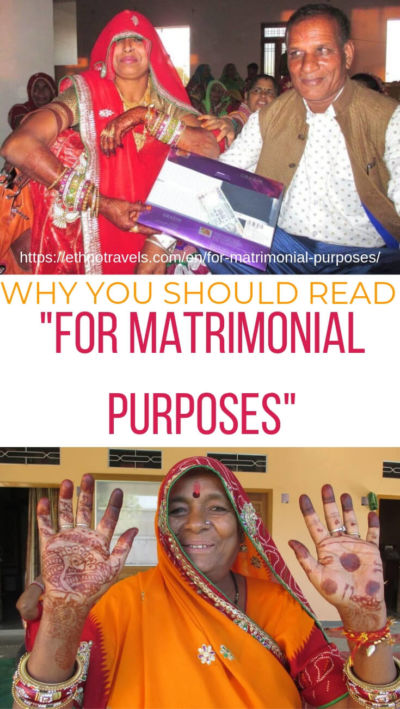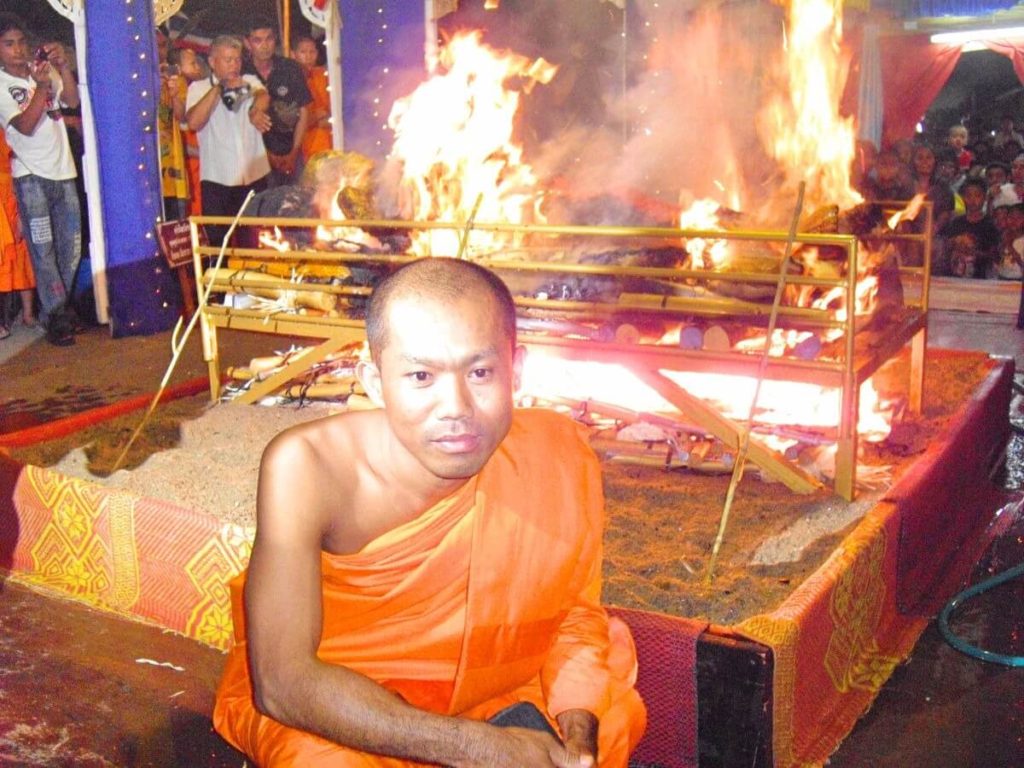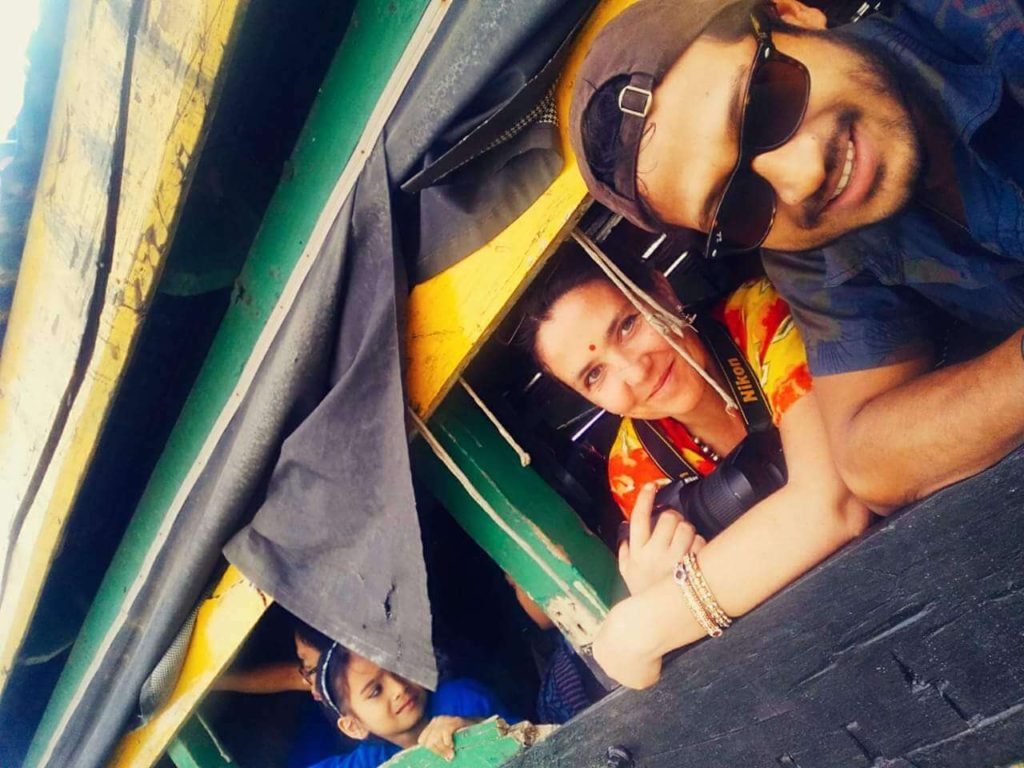In this article, I give you my opinion on the book “For Matrimonial Purposes”, about Indian weddings, drawing a parallel with what I have observed on the ground.
“For matrimonial purposes” is a book I read a few years ago.
I wrote its review at that time and I wanted to update it by including remarks on what I observed during my travels in India.
You will know:
- why I strongly recommend reading it,
- my observations on marriage in India,
- my observations on the place of women in Indian society,
- the surprising conception of higher education.
Note: I get commissions for purchases made through links in this post at no extra charge for you.

>> Check the price and order it here

The story of “For Matrimonial Purposes”.
This is the story of Anju, a 32-year-old Indian woman who moved to New York to live in “Umrique”.
Each year, her parents bring her home for weddings in her family, to enjoy the Great Official Hunt for the Husband; but Anju, torn between Western culture and her roots, has great difficulty finding a solution that allows her to follow tradition while remaining true to herself and her love for freedom.
Why I liked “For Matrimonial Purposes”.
From the first chapter, we discover an author with extraordinary humour and self-derision.
I give you some passages:
“Two days before her tenth birthday, my grandmother was already married. My mother had found a husband when she was twenty. I had concluded that if we were to earn ten years in each generation to reach the ideal age of marriage, at the latest thirty years old I would have had to find a husband.
But at the age of thirty-two, I was far from convoluted, hence the consternation of everyone at my cousin Nina’s wedding, twenty-two years old, to the point of ruining the celebrations and relaunching the family speculations that had been repressed until now.”
“My sari and matching bustier were pale pink, a whipped cream pink, like the glossy mother-of-pearl of a shell, or the knots in little girls’ hair. I had draped myself in nearly seven metres of tightly wrapped fabric around my body, which made me look like an imperial pâté turning pink. In any case, that’s how I described myself to anyone who spread compliments about me.”
About her latest pretender, met in a crappy salsa club: “One of them, in a very fine striped polyester suit, the mustache on the handlebars, told me he wanted to marry me, just before vomiting in a flower pot. It was the last time, quite pathetic, that I had been offered a proposal.”
She will nicknamed the next one “Mr. Mono-brow”: “I was struck by the extreme shine of his hair, as if he had spilled an entire bottle of Vitalis oil on it. He only had one eyebrow. Well, well, not exactly one eyebrow but two eyebrows that joined together. I wanted to go home and come back with my tweezers. He wore a black shirt, covered with small shiny lines, through which you could see a white undershirt, and black pants. And white socks. He also wore a large gold pendant at the end of the chain around his neck, a sparkling bracelet and a watch encrusted with diamonds. I thought I was back in the eighties.”
And the apotheosis, the last lines of this paragraph…
” – Mom, I just want to be happy.
– Beti,” she replied, “I don’t want you to be happy. I want you to be married.”
What I have observed in India, related to Indian weddings and virility.
In families, the order of births is observed.
If the older person is late in getting married, this has an impact on the following people.
What to cause many family crises…
Previously, it was fashionable to wear a moustache to demonstrate virility.
Today, even if hair still has an important place, it is the muscles that win the vote.
In 2015, the young Indians of Jagdalpur to whom I was closest, although of small sizes, were literally transformed and did weight training every day.
Reason?
Most young Indians are obsessed with Salman Khan.
The vast majority of Indian women, including mothers, are secretly in love with the Bad Boy – far too muscular – from Bollywood.
It should be noted that this Indian idol was sentenced in 2015 to 5 years in prison for murder but was immediately released on bail! His appeal request suspended the judgment, we can guess it forever…
Each chapter begins with a quote that reveals a part of Indian culture.
“As a general rule, religious marriage was, and still is, arranged by the parents of the young couple, after extensive consultations, oracle studies, horoscope examinations and physical characteristics conducive… If the husband must be at least twenty years old, the girl must be married just before puberty.” India of Wonders, A. L. Basham.
Now, the age issue is fortunately much more flexible, even if a late marriage is still frowned upon.
In 2012, before joining Orissa and Chhattisgarh, I was in Visakhapatnam, where I had an interesting and funny conversation about marriage with a rich Indian woman. Her daughter, although living in the United States, wanted her mother to find her a husband via marriage websites. Many criteria were taken into account, including the observation of the horoscope.
“Taking the initiative of your marriage is considered totally inappropriate for a young man or a young girl. The current liberalization gives them opportunities to meet, unlike in the past, where young spouses only saw each other after marriage.” Introduction to Hinduism. Dharam Vir Singh.
I don’t count the number of times I’ve heard “this is a love marriage”. Even today, accuracy is still useful, with arranged marriages still being the norm.
I have also unfortunately met young people who are cut off from their families. They had to escape to get married.
In Kerala, a prosperous state, I met a very beautiful young woman married against her will to an older man. She took every opportunity to ask me questions about my life in France and explain that she could not escape. Her husband was just giving her the money she needed for groceries for the family.
In 2015, I was invited to the 1st day of a wedding in a Rajasthan village. The spouses, cousins, had never met before.
“The holy texts prohibit the sacrifice of female animals, but when it comes to human beings, sacrificing women gives the greatest satisfaction.” Chaturanga, Rabindranath Tagore.
No comment…
Although I have not witnessed it, I have been told several times that sati – the sacrifice of the wife in her husband’s funeral pyre – would still sometimes be practiced.
Widows are still often rejected, living alone on the streets.
“The father who does not give his daughter in marriage at the right time is to blame.” Aux sources de la tradition indienne, volume 1, edited by W.M. Théodore de Bary.
About the place of women in Indian society.
“In Hinduism, practicing occultism for personal purposes is frowned upon and anyone who engages in it must be dissuaded.” Am I Hindu? Editions Viswanatham.
However, poor Anju’s desperate mother consult swamis, gurus, healers and astrologers all over the country. It is better to practice occultism than to face disapproving and pitiful looks to have a single daughter!
“Gender discrimination in India begins at birth, or even before. It actually begins in the mother’s womb. None of the traditional blessings given to a pregnant woman mention girls.” The women’s caste, Vrinda Nabar.
India being a huge subcontinent full of contrasts, there are necessarily very different situations in different regions, religions and families. As everywhere and for everything, we must not generalize.
In some families, the wife may have a central role.
Most young people today are happy to have a child, regardless of gender.
Most tribes are matriarchal societies.
Anju evokes the pain and shame she caused her parents by not being born a boy, but a “wrapped waste”. As the eldest member of the family, it was unthinkable that she “made her entrance, with a tiny slit instead of the little worm-shaped appendix that they were so eager to see”.
A girl is very expensive. It must be raised until marriage and then, even though the practice is prohibited by law, a dowry must be offered to the groom’s family.
This tends to be increasingly high and it is not uncommon for the wife to die in an unfortunate domestic accident because of the dowry.
It would also sometimes happen that a young man is kidnapped and forcibly married in order to avoid the bride’s family paying the dowry.
There are still many stories circulating today about dowry-related problems.
During the wedding I attended in Rajasthan, one of the bride’s cousins had to pay a considerable amount for the wedding. Nevertheless, rather than money, the dowry was mainly composed of everything the future spouses needed to settle down: motorcycle, furniture, clothes, etc. Each guest also received a complete lot more or less expensive depending on his proximity to the spouses, consisting of clothes, jewelry, toiletries, money. The men were given a turban, a particularly honourable gesture in Rajasthan. The wedding celebrations lasted a week, alternating gargantuan banquets, traditional rituals and dance evenings.

“A handsome boy with fair skin is generally preferred, especially if the girl is pretty… The boy must be kind, well-mannered and not suggest that he will beat his future wife.” Life in a village in northern India, Oscar Lewis.
Always the cult of white skin, as everywhere in Asia. My Balinese friend Ketut kept telling us that we had beautiful skin, while he had the skin of “Evil” (black).
When I go to Asia, I always make sure I have enough skin cream. On site, I know I will only find it with whitening active ingredients.
About the studies.
“The individual’s aspiration to always pursue studies in order to rise further up the social ladder eventually breaks the established order in the family and creates tensions between women and their main educators” The status of women in India, R. K. Tandon.
One of my Indian friends in Chennai (Madras) has studied for many years and could have become a biochemistry researcher. She comes from a wealthy family. His father is a doctor himself. Yet, just after she finished her studies, she got married – a love marriage. Her father and husband decided that she would not work, which she accepted without difficulty…
“A student, rather than seeing in his diploma what the West would call an enrichment of his vision of things, would come to consider it rather as proof of his greatest personal value, allowing his parents to ask for a more important dowry for him.” May you give birth to a hundred sons, Elisabeth Bumiller.
There again, I no longer count the number of my male acquaintances pursuing studies after 30 yo. However, their ambition is often to work in the administration which, unlike France, represents a prestigious job.
Conclusion – For matrimonial purposes review.
For Matrimonial Purposes is to be discovered if you want to learn a little more about Indian culture, Indian marriage and want to immerse yourself in the atmosphere of a Bombay family’s life.
You will have a great time and have a lot of fun !

>> Check the price and order it here
Feel free to sign up for Amazon Prime’s free trial to benefit from free accelerated delivery and download series, music and books.
Click here to start your free trial now.
Your turn!
Did you ever read “For Matrimonial Purposes? What did you think of it?
Is there another book on India that marked you and that you would recommend to us?
Check out this page for more books suggestions
Save to Pinterest for later.



